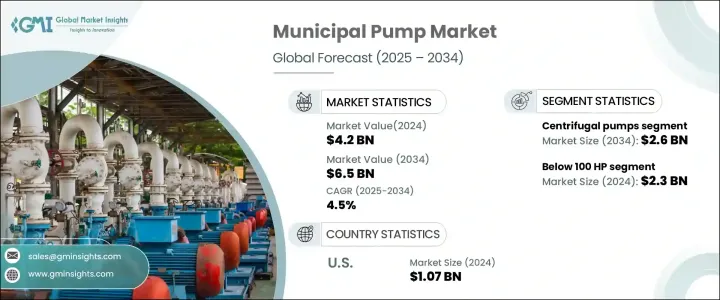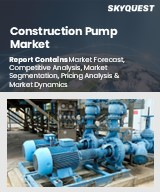
|
시장보고서
상품코드
1716479
지자체 펌프 시장 기회, 성장 촉진 요인, 산업 동향 분석, 예측(2025-2034년)Municipal Pump Market Opportunity, Growth Drivers, Industry Trend Analysis, and Forecast 2025 - 2034 |
||||||
지자체 펌프 세계 시장은 2024년에는 42억 달러로 평가되었으며, 2025년부터 2034년에 걸쳐 CAGR 4.5%로 성장할 것으로 예상됩니다.
지자체 펌프는 고층 빌딩 등의 도시 구조물에 신선한 물을 공급하는 한편, 처리 플랜트나 재생 센터에의 폐수의 효과적인 폐기를 확보하는 중요한 역할을 담당하고 있습니다. 시장의 확장은 급속한 도시화, 엄격한 환경 규제, 그리고 시립 펌프 시스템의 성능과 효율을 높이는 지속적인 기술 혁신이 원동력이 되고 있습니다.

스마트 테크놀로지는 업계에 혁명을 일으켜 실시간 모니터링 및 원격 관리를 가능하게 함으로써 효율성 향상과 운전 비용 절감을 실현하고 있습니다. 신흥경제국의 노후화된 물 인프라 업그레이드와 수처리시설 확대를 위한 투자 증가는 최신 지자체 펌프 시스템 채용에 더욱 박차를 가하고 있습니다.
| 시장 범위 | |
|---|---|
| 시작 연도 | 2024년 |
| 예측 연도 | 2025-2034년 |
| 시작 금액 | 42억 달러 |
| 예측 금액 | 65억 달러 |
| CAGR | 4.5% |
2024년에 16억 달러의 수익을 거둔 원심 펌프 분야는 2034년까지 26억 달러로 성장할 것으로 예측됩니다. 다양한 자치체의 용도로 안정적이고 신뢰성이 높은 운전이 보장되므로 배수나 폐수처리 프로세스에서 선호되는 선택사항이 되고 있습니다.
마력별로 보면 100HP 미만의 부문은 2024년에 23억 달러를 차지했으며 시장의 55%의 점유율을 획득했습니다. 이 펌프는 초기 투자와 운용 비용이 낮아 예산 제약 속에서 일하는 지자체에게 매력적인 선택이 되고 있습니다.
미국 시립 펌프 시장은 2024년에는 10억 7,000만 달러로 평가되었고, 2025년부터 2034년까지 연평균 복합 성장률(CAGR) 4.9%로 성장할 것으로 예상됩니다. 이 시장의 성장은 펌프 시스템의 효율과 성능을 향상시킨 기술의 진보에 따른 점이 큽니다. 고효율 모터와 가변 주파수 드라이브와 같은 에너지 효율적인 솔루션은 지자체가 에너지 소비를 최소화하면서 엄격한 환경 규제를 충족시키는 데 도움을 줍니다.
목차
제1장 조사 방법과 조사 범위
제2장 주요 요약
제3장 업계 인사이트
- 생태계 분석
- 밸류체인에 영향을 주는 요인
- 이익률 분석
- 혁신
- 장래의 전망
- 제조업체
- 유통업체
- 영향요인
- 성장 촉진요인
- 도시화와 인프라 개발의 진전
- 엄격한 환경 규제
- 급속한 기술 진보
- 업계의 잠재적 위험 및 과제
- 높은 이니셜 코스트
- 보수 및 수리 비용
- 성장 촉진요인
- 기술 개요
- 성장 가능성 분석
- Porter's Five Forces 분석
- PESTEL 분석
제4장 경쟁 구도
- 소개
- 기업 점유율 분석
- 경쟁 포지셔닝 매트릭스
- 전략 전망 매트릭스
제5장 시장 추정 및 예측 : 펌프 유형별, 2021년-2034년
- 주요 동향
- 소용돌이 펌프
- 하수 펌프
- 기어 펌프
- 펄프 펌프
- 다이어프램 펌프
- 기타(물 펌프, 프로세스 펌프 등)
제6장 시장 추정 및 예측 : 동력원별, 2021년-2034년
- 주요 동향
- 전기·솔러 펌프
- 디젤 펌프
- 기타(휘발유, 태양 등)
제7장 시장 추정 및 예측 : 유량별, 2021년-2034년
- 주요 동향
- 100 m³/h 미만
- 100-500 m³/h
- 500m³/h 이상
제8장 시장 추정 및 예측 : 마력별, 2021년-2034년
- 주요 동향
- 100마력 미만
- 100-500 마력
- 500마력 이상
제9장 시장 추정 및 예측 : 기술별, 2021년-2034년
- 주요 동향
- 기존
- 스마트
제10장 시장 추정 및 예측 : 용도별, 2021년-2034년
- 주요 동향
- 클린 워터 시스템
- 폐수 및 오수 처리
- 중수 재활용
- 기타
제11장 시장 추정 및 예측 : 유통 채널별, 2021년-2034년
- 주요 동향
- 직접
- 간접판매
제12장 시장 추정 및 예측 : 지역별, 2021년-2034년
- 주요 동향
- 북미
- 미국
- 캐나다
- 유럽
- 독일
- 영국
- 프랑스
- 이탈리아
- 스페인
- 아시아태평양
- 중국
- 인도
- 일본
- 한국
- 호주
- 라틴아메리카
- 브라질
- 멕시코
- 아르헨티나
- 중동 및 아프리카
- UAE
- 사우디아라비아
- 남아프리카
제13장 기업 프로파일
- Blackmer
- CORNELL PUMP COMPANY
- Crane Pumps &Systems
- EBARA Pumps Americas Corporation
- EXAIR LLC
- Grundfos Pumps Corporation
- Liberty Pumps
- MDM Incorporated
- NETZSCH Pumps &Systems
- Pentair plc
- SEEPEX, Inc.
- Smith &Loveless Inc.
- Sulzer Ltd
- Wanner Engineering, Inc
- Xylem Inc
The Global Municipal Pump Market was valued at USD 4.2 billion in 2024 and is projected to grow at a CAGR of 4.5% between 2025 and 2034. Municipal pumps play a critical role in supplying fresh water to urban structures such as high-rise buildings while ensuring the effective disposal of wastewater to treatment plants and reclamation centers. The market's expansion is driven by rapid urbanization, stricter environmental regulations, and ongoing technological innovations that are enhancing the performance and efficiency of municipal pump systems. As cities continue to grow and populations increase, the demand for reliable and energy-efficient municipal pumps will rise, contributing to the market's sustained growth.

Smart technologies are revolutionizing the industry, enabling real-time monitoring and remote management of pump operations, which improves efficiency and reduces operational costs. These advanced systems, coupled with energy-efficient solutions such as high-efficiency motors and variable frequency drives, are allowing municipalities to meet stringent environmental standards while minimizing energy consumption. Moreover, increasing investments in upgrading aging water infrastructure in developed economies and expanding water treatment facilities in emerging markets are further fueling the adoption of modern municipal pump systems. Governments are prioritizing the replacement of outdated systems to reduce leakage, enhance water quality, and optimize resource management, making the adoption of smart pump solutions a key focus area for municipalities.
| Market Scope | |
|---|---|
| Start Year | 2024 |
| Forecast Year | 2025-2034 |
| Start Value | $4.2 Billion |
| Forecast Value | $6.5 Billion |
| CAGR | 4.5% |
The centrifugal pump segment, which earned USD 1.6 billion in 2024, is expected to grow to USD 2.6 billion by 2034. These pumps dominate the market due to their reliability and efficiency in handling large volumes of water and wastewater. Their ability to manage various flow rates and pressures ensures steady and reliable operation across different municipal applications, making them the preferred choice for water distribution and wastewater treatment processes. The versatility of centrifugal pumps makes them ideal for a wide range of municipal operations, from moving clean water to managing sewage and other waste products.
In terms of horsepower, the below 100 HP segment accounted for USD 2.3 billion in 2024, capturing a 55% share of the market. Pumps with lower horsepower are commonly used in municipal applications where high power is unnecessary, such as smaller water distribution networks, sewage treatment facilities, and irrigation systems. These pumps offer lower upfront and operational costs, making them an attractive option for municipalities working within budget constraints. Their ability to manage moderate flow rates and pressures efficiently makes them highly suitable for various municipal settings, ensuring reliable performance while minimizing costs.
The U.S. municipal pump market was valued at USD 1.07 billion in 2024 and is expected to grow at a CAGR of 4.9% between 2025 and 2034. The growth of this market is largely attributed to technological advancements that have improved the efficiency and performance of pump systems. The adoption of smart technologies has enabled real-time monitoring and remote management of pump operations, allowing municipalities to reduce operational costs and enhance overall efficiency. Energy-efficient solutions such as high-efficiency motors and variable frequency drives are helping municipalities meet stringent environmental regulations while minimizing energy consumption. U.S. water quality standards have created a strong demand for advanced pump technologies that comply with these guidelines, further boosting market growth and encouraging the adoption of next-generation municipal pump systems.
Table of Contents
Chapter 1 Methodology & Scope
- 1.1 Market scope & definition
- 1.2 Base estimates & calculations
- 1.3 Forecast parameters
- 1.4 Data sources
- 1.4.1 Primary
- 1.4.2 Secondary
- 1.4.2.1 Paid sources
- 1.4.2.2 Public sources
Chapter 2 Executive Summary
- 2.1 Industry 3600 synopsis, 2021 - 2034
Chapter 3 Industry Insights
- 3.1 Industry ecosystem analysis
- 3.1.1 Factor affecting the value chain
- 3.1.2 Profit margin analysis
- 3.1.3 Disruptions
- 3.1.4 Future outlook
- 3.1.5 Manufacturers
- 3.1.6 Distributors
- 3.2 Impact forces
- 3.2.1 Growth drivers
- 3.2.1.1 Growing Urbanization & Infrastructure development
- 3.2.1.2 Strict Environmental regulations
- 3.2.1.3 Rapid Technological advancements
- 3.2.2 Industry pitfalls & challenges
- 3.2.2.1 High initial costs
- 3.2.2.2 Maintenance and repair costs
- 3.2.1 Growth drivers
- 3.3 Technological overview
- 3.4 Growth potential analysis
- 3.5 Porter's analysis
- 3.6 PESTEL analysis
Chapter 4 Competitive Landscape, 2024
- 4.1 Introduction
- 4.2 Company market share analysis
- 4.3 Competitive positioning matrix
- 4.4 Strategic outlook matrix
Chapter 5 Market Estimates & Forecast, By Pump Type, 2021 – 2034 (USD Billion) (Thousand Units)
- 5.1 Key Trends
- 5.2 Centrifugal pumps
- 5.3 Sewage pumps
- 5.4 Gear pumps
- 5.5 Pulp pumps
- 5.6 Diaphragm pumps
- 5.7 Others (Water Pumps, Process Pumps, etc.)
Chapter 6 Market Estimates & Forecast, By Power Source, 2021 – 2034 (USD Billion) (Thousand Units)
- 6.1 Key trends
- 6.2 Electric & solar pumps
- 6.3 Diesel pumps
- 6.4 Others (gasoline, solar, etc.)
Chapter 7 Market Estimates & Forecast, By Flow Rate, 2021 – 2034, (USD Billion) (Thousand Units)
- 7.1 Key trends
- 7.2 Below 100 m³/h
- 7.3 100 - 500 m³/h
- 7.4 Above 500 m³/h
Chapter 8 Market Estimates & Forecast, By Horse Power, 2021 – 2034, (USD Billion) (Thousand Units)
- 8.1 Key trends
- 8.2 Below 100 HP
- 8.3 100 - 500 HP
- 8.4 Above 500 HP
Chapter 9 Market Estimates & Forecast, By Technology, 2021 – 2034, (USD Billion) (Thousand Units)
- 9.1 Key trends
- 9.2 Conventional
- 9.3 Smart
Chapter 10 Market Estimates & Forecast, By Application, 2021 – 2034, (USD Billion) (Thousand Units)
- 10.1 Key trends
- 10.2 Clean water systems
- 10.3 Wastewater and sewage handling
- 10.4 Grey water recycling
- 10.5 Others
Chapter 11 Market Estimates & Forecast, By Distribution Channel, 2021 – 2034, (USD Billion) (Thousand Units)
- 11.1 Key trends
- 11.2 Direct
- 11.3 Indirect
Chapter 12 Market Estimates & Forecast, By Region, 2021 – 2034, (USD Billion) (Thousand Units)
- 12.1 Key trends
- 12.2 North America
- 12.2.1 U.S.
- 12.2.2 Canada
- 12.3 Europe
- 12.3.1 Germany
- 12.3.2 U.K.
- 12.3.3 France
- 12.3.4 Italy
- 12.3.5 Spain
- 12.4 Asia Pacific
- 12.4.1 China
- 12.4.2 India
- 12.4.3 Japan
- 12.4.4 South Korea
- 12.4.5 Australia
- 12.5 Latin America
- 12.5.1 Brazil
- 12.5.2 Mexico
- 12.5.3 Argentina
- 12.6 MEA
- 12.6.1 UAE
- 12.6.2 Saudi Arabia
- 12.6.3 South Africa
Chapter 13 Company Profiles (Business Overview, Financial Data, Product Landscape, Strategic Outlook, SWOT Analysis)
- 13.1 Blackmer
- 13.2 CORNELL PUMP COMPANY
- 13.3 Crane Pumps & Systems
- 13.4 EBARA Pumps Americas Corporation
- 13.5 EXAIR LLC
- 13.6 Grundfos Pumps Corporation
- 13.7 Liberty Pumps
- 13.8 MDM Incorporated
- 13.9 NETZSCH Pumps & Systems
- 13.10 Pentair plc
- 13.11 SEEPEX, Inc.
- 13.12 Smith & Loveless Inc.
- 13.13 Sulzer Ltd
- 13.14 Wanner Engineering, Inc
- 13.15 Xylem Inc



















